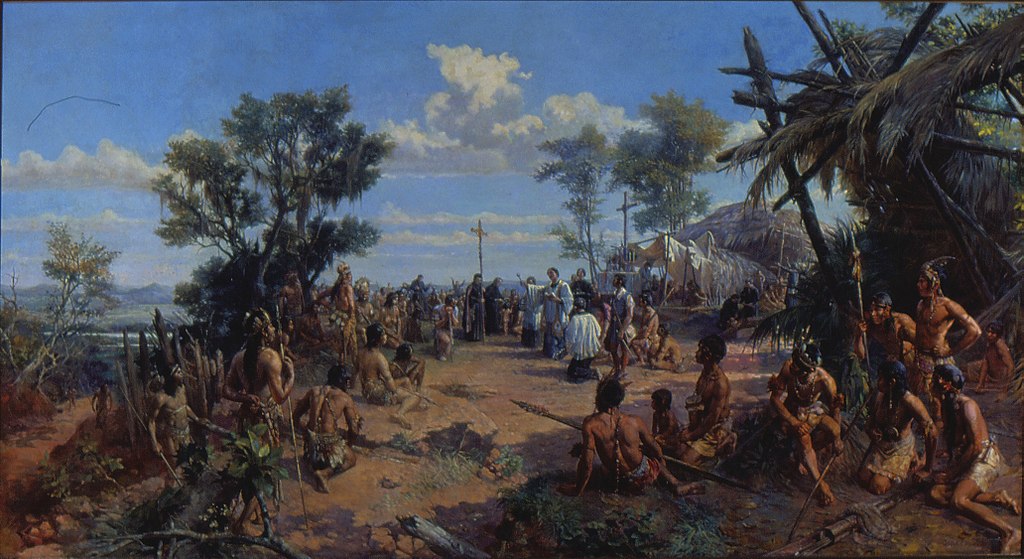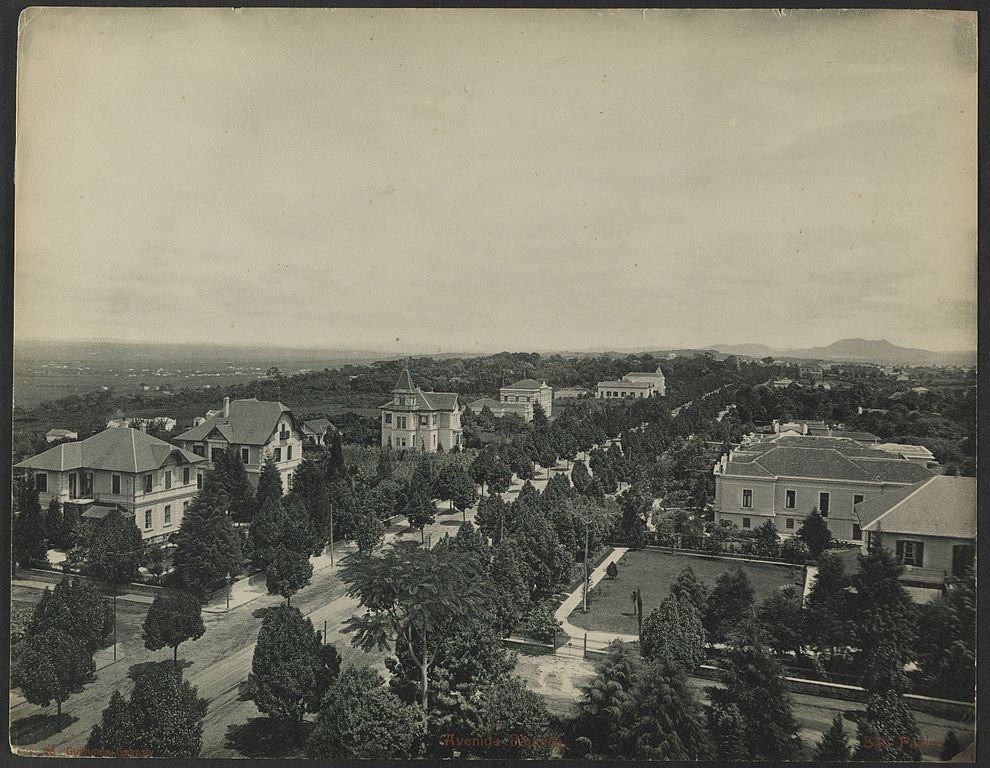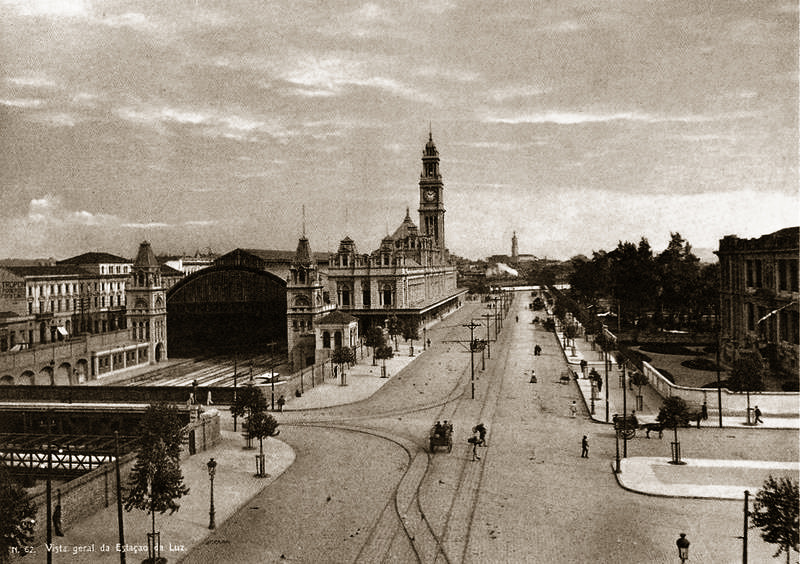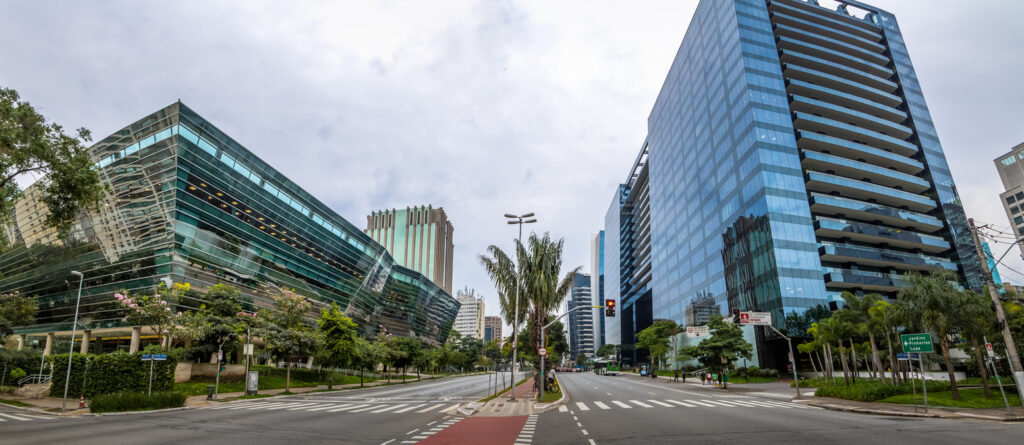THE BEGINNING
The history of São Paulo begins with the arrival of the Portuguese in Brazil. The colonization and occupation of the territory of what is now the State of São Paulo begins in 1532 with the founding of São Vicente Village, a region of the current city of Santos, on the coast.
With the aim of catechizing the indigenous population in Brazilian lands, in 1554, the Jesuit mission led by Manuel da Nóbrega and José de Anchieta, left São Vicente Village towards the plateau. After facing the climb of mountain range called Serra do Mar, they arrive at a place known as Piratininga and decide to settle on a hill bordered by two valleys where the Tamanduateí and Anhangabaú rivers flow.
And in this place of safe topography, they founded the Páteo do Colégio, where the first mass was held on January 25, 1554, the same date that the Apostle Paul converted to Christianity. That’s why the mass is dedicated to him and the name “Sao Paulo” is chosen as a tribute to represent the place that is now called “São Paulo de Piratininga“.

THE DISCOVERY OF GOLD
However, the region made up of what are today the States of São Paulo and Minas Gerais, did not produce wealth or possess extractive goods and was the poorest territory in the Portuguese colony in America. Far from the capital of the colony, which was the city of Salvador, its development took place slowly. Until the mid-1690s, the first gold mines began to be found in the region of Minas Gerais, a neighboring state of Sao Paulo. This fact caused the attention of the kingdom of Portugal to turn to the region. In 1711, São Paulo was elevated to the category of “city”.
With the end of the gold cycle in the 18th century, sugar cane cultivation gained prominence in the following years.
RISE AND FALL OF THE BRAZIL EMPIRE
In the geopolitical field, many events took place in the 19th century. On September 7, 1822, Brazil’s independence from Portugal was declared by Dom Pedro I, on the banks of the Ipiranga River in Sao Paulo. Since then, the period of Imperial Brazil has been established, whose capital is the city of Rio de Janeiro. Dom Pedro I is titled the first emperor of Brazil and is later succeeded by Dom Pedro II.
Around the 1870s, the monarchy was being questioned by various groups in society, mainly the military. If before the province of Sao Paulo had little political importance in the Brazilian scenario, with the clear expansion and growth due to the planting and commercialization of coffee, Sao Paulo now claims greater political representation. In this scenario, groups from Sao Paulo began to encourage and strengthen the idea of Brazil as a Republic.
The republican movement grows throughout the country and with the support of the military,
The Proclamation of the Republic took place on November 15, 1889, in Rio de Janeiro, the country’s capital. It is the end of the Brazilian Empire.
SAO PAULO GROWS WITH THE COFFEE CYCLE
In the economic field, the 19th century was promising. Around 1825, the first coffee plantations appeared in the Paraíba River Valley. Due to the climate and soil conditions, coffee agriculture is expanding throughout the region that covers the states of Sao Paulo, Minas Gerais and Rio de Janeiro. It is the beginning of great population and economic growth in the State of Sao Paulo.
In 1860, Brazil accounted for 60% of world coffee production.
The following years were very successful in coffee farming and made the State of Sao Paulo one of the richest in Brazil. With the ban on the use of slave labor in 1888 in Brazil, the arrival of immigrants, mainly Italians and Japanese, to work in the coffee plantations increased.
At the end of the 19th century, in order to transport production, several railways emerged that connected the interior of the state to the capital São Paulo. The production and export of coffee made the city of Sao Paulo the point of convergence, and it is in this context that Luz Station and Julio Prestes Station emerged. The city developed and reached its peak with the construction of Paulista Avenue in 1900, a location chosen by the main coffee producers to build their mansions.


GROWTH OF INDUSTRIALIZATION
In 1872, a textile factory was the first industry in the city of São Paulo to be founded. 20 years later, around 50 factories from various sectors such as textiles, consumer goods and basic industry were present in the city, the majority located in the Brás neighborhood.
With the occurrence of the First World War (1914-1918), the arrival of products from other countries became more difficult, this ended up being a factor that contributed to encouraging internal industrialization. From 1920 onwards, the farms on the outskirts of the city center gave way to new residential neighborhoods and the urban area expanded.
The stock market crash of 1929 further enhanced the development of industrialization. Coffee production loses its export market and the product becomes devalued. Many coffee producers began to invest their accumulated wealth in diversified industries. They also ended up absorbing the labor of immigrants, who previously worked in agriculture, as most immigrants of European origin already had industrial experience, as Europe had already gone through the industrialization process.
During this period, according to IBGE data, the population increased from 30,000 inhabitants in 1872 to 570,000 inhabitants in 1920, a very significant growth.
THE DEVELOPMENT OF THE METROPOLIS
With the growth and concentration of several industries in the city, a favorable scenario was created for the expansion of commercial activities and also the services sector. With job opportunities in various areas such as industry, commerce and services, the migratory flow from various regions of the country towards the city of Sao Paulo intensifies.
Thus, the 1960 census makes the city of São Paulo official as the largest and richest in the country with around 3.8 million inhabitants. As a consequence of rapid growth, the city expands in a disorderly manner.
In 1980, the population was around 8.5 million inhabitants.
The following decades still saw the city’s population grow, but at a slower pace. If previously industries employed a large part of the population, in the 2000s the workforce is concentrated in the services sector, such as technology, IT, communication.
The 2022 census shows the city’s population at around 11.5 million inhabitants, the fifth largest in the world. If we consider the capital plus the municipalities that make up the metropolitan region, we reach 21 million inhabitants, we are talking about the seventh largest metropolis in the world.
CONTEMPORARY SAO PAULO
The city today has an economy that is mostly concentrated in the service sector. And in recent years he has ended up specializing in more complex and competitive activities, which require the most qualified use of new technologies, linked to information technology and communication.
It’s in Sao Paulo where everything happens. Where new ideas emerge, where information is concentrated, where the most modern buildings are, where the people are. It’s where startups are, the headquarters of the main national and multinational companies, the headquarters of large banks, and the headquarters of important law firms. All of this makes it a city with a strong economy and the country’s financial center.
São Paulo is today a modern, globalized metropolis and even with all the pros mentioned above it is still a complex city: at the same time as it is the financial capital of the country, it has its challenges in the social area with the issue of housing and security due to example.

Source:
https://pt.wikipedia.org/wiki/S%C3%A3o_Paulo
https://exame.com/economia/a-metropole-improvavel-por-que-sao-paulo-virou-a-maior-cidade-do-brasil/
https://educacao.uol.com.br/disciplinas/geografia/concentracao-e-desconcentracao-industrial-sao-paulo-e-centro-industrial-do-pais.htm
https://www.prefeitura.sp.gov.br/cidade/secretarias/upload/50_Trabalho_2019.pdf
